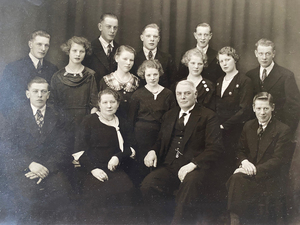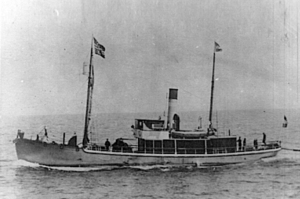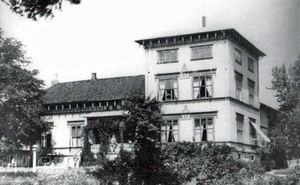HANSEN, CARL ANTON
1882-1961 from Norway
whaling gunner and ship’s captain was born at Breili, Sandeherred (now Sandar) near Sandefjord in Norway on 31 August 1882, the son of Anders Kristian ‘Marum’ Hansen and Karen Amalie née Knutsdatter. Hansen went to sea at the age of 14 years and a few years later found himself on Johan Bryde’s barque Mathilde, trading to South America. His first association with whaling may have been in 1900 when he was employed by Thor Dahl of Sandefjord on the whaling schooner Mariane which hunted bottlenose whales in the Norwegian and Greenland Seas. By 1903 he had been promoted to gunner on Chr. Christensen’s and Lindenberg’s Fremad trading under the name of A/S Oceana. This was at that time the largest sealing and whaling company in Sandefjord and in Norway.
Hansen’s reputation as a gunner soon became well known. When in the Spring of 1904 Captain CA LARSEN began to put together the crew for his whaling expedition to South Georgia, he sought out Hansen as gunner for his newly built catcher Fortuna. Hansen later recorded the event that secured his appointment. A man with a stiff hat rowed along the side of the ship and shouted: ‘Is Anders Marum’s son here?’ ‘I am him’, replied Hansen. And this was how Larsen hired Hansen, and so began a career where he was to spend some 34 seasons working in the Southern Ocean for many companies. On 2 December 1904 he shot the first whale at South Georgia, thereby starting what many have called ‘the great southern whaling industry’ which lasted at South Georgia until the mid-1960s. His appointment was a great success, and in his first fourteen months in the employ of Larsen’s Compañia Argentina de Pesca at Grytviken he captured some 183 whales, primarily humpbacks.
Initially Hansen was employed at 70 kroner per month with a four kroner bonus per whale, but this soon increased to 125 kroner per month. With his great ability to capture all species of whales, including the large blue and fin and the valuable southern right whale, for which he was paid 50 kroner bonuses, his personal return increased substantially. At the end of 1905 he had accumulated some 2,762 kroner (circa £150) a substantial figure for those days.
Gunner Hansen was at Grytviken in 1906 when the British warship HMS Sappho visited the Island to inspect the whaling station on behalf of the government. There had been much trepidation among the Norwegian crews and Larsen’s family following its arrival. However, Hansen, in an interview with a Norwegian newspaper some years later said he remembered the event well. He recalled that those at Grytviken found themselves entangled ‘in a diplomatic hiatus’. The Sappho sent a ‘prize crew’ ashore, smiled at the Argentine flag and hoisted the Union Jack. CA Larsen, being the cool diplomat that he was, soon had the situation under control and the tension was dissolved in great friendliness.
Hansen also recalled that before HMS Sappho sailed away, Captain Larsen invited the Sappho’s commander Michael Henry Hodges to take a sightseeing trip to Antarctic Bay in the whale catcher Fortuna, where a vicious snowstorm forced them to anchor for the night. The following morning, with plenty of humpbacks in sight, gunner Hansen suggested to Larsen that they should invite Commander Hodges to shoot a whale. Larsen thought it was a good idea, which the Commander accepted with enthusiasm and which he duly succeeded in fulfilling. Hansen said that the Commander was so elated by the event that he invited himself, Larsen and the whole of Fortuna’s crew aboard the cruiser as his guests.
On 16 September 1900 Hansen married Anna Marie Kristensen (1879-1938) and by 1904 he had fathered four children. Unfortunately, they saw very little of their father as he was engaged permanently at South Georgia until he returned home in 1907 to collect a new catcher for the Pesca company, the Karl, from the builders Framnæs Værksted.
In 1908 he left the employ of CA Larsen and was engaged by a rival Sandefjord based South Georgia company Sandefjords Hvalfangerselskab as a gunner on their catcher Hercules based at Stromness Harbour. The following season he moved to Bryde & Dahl’s Snorre working from Godthul, South Georgia with the factory ship Admiralen and in 1910 to A/S Ørnen (Chr. Christensen’s) Hauken, working with the factory ship Ørn at the South Shetland Islands. There is little doubt that by shifting his employment he was able to improve his terms of engagement and increase his growing personal wealth.
Hansen appears to have remained with A/S Ørnen through the First World War but in 1920/21 he was working once again from Stromness Bay, South Georgia, for the company A/S Vestfold. In 1923, however, he was in the employ of the British owned Southern Whaling & Sealing Company, part of the Lever Brothers soap and margarine empire which had a whaling base at Prince Olav Harbour, South Georgia and a factory ship Southern Queen which worked along the Antarctic peninsula. Levers were prepared to pay high salaries and bonuses for the best gunners, and there is little doubt Hansen was handsomely rewarded. He remained in Southern Whaling’s employ until the Southern Queen sank after a collision with the ice in February 1928. By this time Hansen had risen to the status of whaling manager, and he was probably employed in managing and directing the catcher fleet.
After his unexpected withdrawal from Lever Brothers, Hansen was employed on the factory ship Sevilla for companies based both in Sandefjord and Tønsberg. This continued until the financial crisis of 1930/31, brought about by too many whaling expeditions and the overproduction of whale oil, heralded a temporary halt to all Norwegian whaling expeditions.
By this time Hansen had become a wealthy man. He purchased the estate Vestre Freberg, which consisted of the largest villa in Sandar named Frebergslottet, built in 1865 on the outskirts of Sandefjord. There he could house some of his large family of thirteen children, eight sons and five daughters.
The crisis of 1930/31 saw many changes in the whaling industry. There was an agreement to control the number of whaling ships, limit the production of oil and introduce some conservation measures to prevent the over-exploitation of whale species. Many old whaling ships were sent to the breakers yard, and they were replaced by a smaller number of larger factory ships equipped with stern slips which could haul up and butcher the whale on board. Hansen worked for very many years for A/S Kosmos as a catcher gunner on the Kos XV assigned to one of these expeditions, the Kosmos II, which each austral season processed thousands of whales in the Southern Ocean.
Following the death of his wife in 1938, Hansen retired from whaling having captured over 6,000 whales in his career. A year later he sold his estate to live in more modest accommodation. His rapport with the whaling industry, however, continued and in 1947/48 he was asked by Kosmos owner Anders Jahre to train and supervise a group of budding ‘skytters’ (whale gunners) on the catcher Kos X, where his sons Gudmund Dagfinn Hansen (b.1910) served as mate and Torbjørn Kristen (b.1913) as an able-bodied seaman. Another son Erling Anton (1917-2001) also served as ship’s mate and telegraphist on the Kos XXIII in 1939/40 under the infamous gunner Lars Andersen. This was Hansen’s last foray into the Southern Ocean.
Carl Hansen died in Sandefjord on 23 January 1961, ironically at the time when ‘Norwegian’ whaling from South Georgia, where 175,250 whales had been taken since 1904, was coming to an end.
Comments
Revisions
October 2021 Biography first added to the Dictionary


